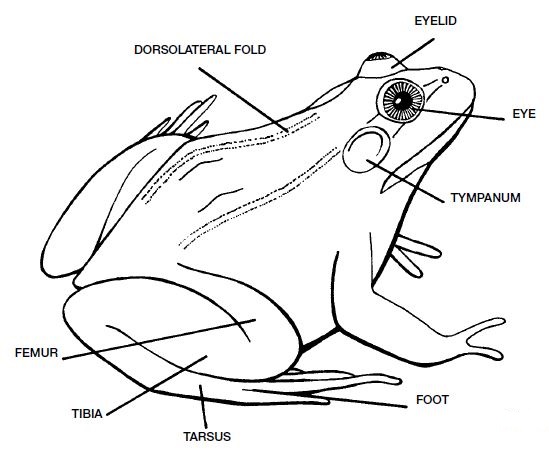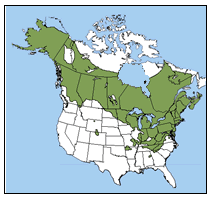Wood frog: Difference between revisions
No edit summary |
No edit summary |
||
| Line 4: | Line 4: | ||
[[File:wood-frog.jpg]] | [[File:wood-frog.jpg]] | ||
[[File:WFTAnatomyBW.jpg]] | |||
The Wood frog is a comparatively small frog. Fully grown adults are 1.5 to 3.25 inches in length. Females are typically larger and more brightly colored than their male counterparts. They can differ in color, but bodies typically range from a light tan to a dark brown. Their most distinct feature is the coloration around their eyes. The Wood frog has two black markings that extend back from their eyes, resembling a mask. The underbelly is white sometimes with the occasional grey mark. This frog has two distinct ridges that run down their back. These ridges are known as Dorsolateral folds. | The Wood frog is a comparatively small frog. Fully grown adults are 1.5 to 3.25 inches in length. Females are typically larger and more brightly colored than their male counterparts. They can differ in color, but bodies typically range from a light tan to a dark brown. Their most distinct feature is the coloration around their eyes. The Wood frog has two black markings that extend back from their eyes, resembling a mask. The underbelly is white sometimes with the occasional grey mark. This frog has two distinct ridges that run down their back. These ridges are known as Dorsolateral folds. | ||
Revision as of 18:09, 11 March 2022
The Wood Frog otherwise known as Lithobates sylvaticus is a terrestrial frog found throughout North America. In Greek Litho translates to "a stone", bates translates to "one that walks", and sylvaticus meaning "amidst the trees". This species of frog is common and is not currently under any threat of extinction. They belong to the Order Anura and the Family Ranidae.
Description
The Wood frog is a comparatively small frog. Fully grown adults are 1.5 to 3.25 inches in length. Females are typically larger and more brightly colored than their male counterparts. They can differ in color, but bodies typically range from a light tan to a dark brown. Their most distinct feature is the coloration around their eyes. The Wood frog has two black markings that extend back from their eyes, resembling a mask. The underbelly is white sometimes with the occasional grey mark. This frog has two distinct ridges that run down their back. These ridges are known as Dorsolateral folds.
Distribution and Habitat
Wood Frogs can be found through most of Canada and Alaska and as far south as northern Georgia. In the United States they are mostly found in the Northeastern states. Wood frogs are forest dwelling amphibians. During the summer months they can be found in an moist forested areas, ravines, bogs or forested swamps. During the winter months they seek refuge in leaf litter in the uplands. When spring comes they migrate into forested wetlands or other protected bodies of water to breed. This migration can be somewhat explosive with large numbers migrating. During mating season, these frogs find temporary pools of water of vernal pools. These can be any cut off water sources like streams or ponds, and can even be in ditches. These are usually free of fish to increase survivability of the offspring. Wood frogs are diurnal and are rarely seen at night but often heard in loud choruses during mating season.
Cold Tolerance
Wood frogs have a freeze tolerance and are one of the only amphibians to inhabit the Arctic Circle. Their freeze tolerance is due to the rapid synthesis of glucose from liver glycogen and the distribution of this cryoprotective agent to cells throughout the body. The distribution of liver glycogen enhances the survival of cells, tissues, and organs. This was seen by experimentally adding additional glucose to the frog which increases its tolerance to freezing (Costanzo et al. 1993). This glucose distribution raises the osmotic pressure of the body fluids, which in turn reduces the amount of ice that forms at any given temperature. The extra gluclose will cause a decrease in the degree of cell shrinkage during freezing, and also works as a fermentable fuel that can be metabolized in the absence of oxygen. The wood frog also uses urea as a cryoprotectant. Unlike glucose, urea is accumulated during autumn and early winter, and is already localized within cells when freezing begins. Some evidence suggests that urea is more efficacious than glucose in preventing cryoinjury (Costanzo and Lee 2005).
Diet
Wood Frogs are omnivores. While inhabiting the forests as adults they feed on a variety of small invertebrates that they find on the forest floor. As tadpoles they will feed on algae or detritus and even larvae of amphibians. Cannibalism has often been observed in tadpoles when starvation is the alternative.
Reproduction
The Wood frogs emerge from the leaf litter in late winter or early spring, usually March. The head to a nearby body of water and begin looking for a mate. The male wood frog has a short quack like mating call. Once the frogs pair the female will lay egg clutches of 300-1000 eggs. The eggs will hatch between 9 to 30 days after they are laid. Males will mature between 1 and 2 years and Females after about 3 years. Some individuals will only reproduce once in there lives, others two or three times as their life span is on average 4 years.
References
Berven, Keith A., and Thaddeus A. Grudzien. “Dispersal in the Wood Frog (Rana Sylvatica): Implications for Genetic Population Structure.” Evolution, vol. 44, no. 8, 1990, pp. 2047–56. JSTOR, doi:10.2307/2409614.
Conlon, J. M., et al. “Freeze Tolerance in the Wood Frog Rana Sylvatica Is Associated with Unusual Structural Features in Insulin but Not in Glucagon.” Journal of Molecular Endocrinology, vol. 21, no. 2, Oct. 1998, pp. 153–59. PubMed, doi:10.1677/jme.0.0210153.
Costanzo, Jon P., et al. “Cryoprotectants and Extreme Freeze Tolerance in a Subarctic Population of the Wood Frog.” PLOS ONE, vol. 10, no. 2, Feb. 2015, p. e0117234. PLoS Journals, doi:10.1371/journal.pone.0117234.
“Explosive Breeding Reduces Egg and Tadpole Cannibalism in the Wood Frog, Rana Sylvatica.” Animal Behaviour, vol. 50, no. 3, Jan. 1995, pp. 731–39. www.sciencedirect.com, doi:10.1016/0003-3472(95)80133-2.
Virginia Herpetological Society. http://www.virginiaherpetologicalsociety.com. Accessed 4 May 2021.
“Wood Frog | Vermont Center for Ecostudies.” Vermont Center for Ecostudies | Uniting People & Science for Conservation, 5 June 2014, https://vtecostudies.org/wildlife/amphibians/wood-frog/.


